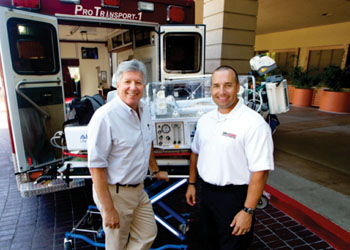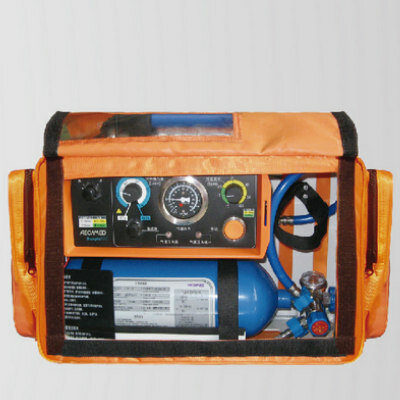New System Simplifies Emergency Patient Transfers
|
By HospiMedica International staff writers Posted on 15 Apr 2015 |

Image: Ronald Cohen, MD, and Brandon Bond (Photo courtesy of Norbert von der Groeben/ Stanford).
A new electronic medical record (EMR) system helps make patient transport to other facilities safer and more efficient in the event of a major crisis, such as an earthquake or power outage.
Developed by researchers at Stanford University (CA, USA) the triage by resource allocation for inpatients (TRAIN) program helps determine what vehicles and equipment are necessary for continuous patient care during a crisis event, as well as simplifying communicating patients’ needs to other hospitals or command centers coordinating transfers. Using the system, caregivers have prompt access to a fully automated report that categorizes patients in terms of their specific needs, such as what medication they receive, whether they are on ventilators, if they need intravenous (IV) lines, or whether they require an intensive care unit (ICU) bed.
Under TRAIN, all patients are assigned a color. For example, patients that need specialized transport, such as an ambulance or military vehicle, in addition to life-support equipment, such as ventilators and multiple intravenous drips for medication, can be categorized instantly with a single word: red. In comparison, patients marked with blue tags are considered stable and can be transported in a car or bus, without any specialized equipment. TRAIN thus allows care teams to communicate the medical needs of the specific patient, as well as the severity of his or her condition.
“We can see exactly what resources are needed for each patient at all times. Should we have to evacuate, which we hope we never have to do, TRAIN puts us far ahead in terms of keeping our patients safe during an incident,” said Brandon Bond, director of the office of emergency management for the hospitals at Stanford. “We can see exactly what resources are needed for each patient at all times.”
“Once we had the algorithm, we knew our electronic medical record could easily calculate the TRAIN classification. Most importantly, the calculation could be done in an instant, without any additional work from doctors or nurses,” said Ronald Cohen, MD, clinical professor of neonatal and developmental medicine at Stanford school of medicine. “The computer system automatically categorizes patients based on their needs, and that report is always on hand. This would take hours to do manually, but it’s now available instantly, 24 hours a day. It’s an extremely valuable tool that hopefully we’ll never need.”
TRAIN is based on the Epic (Verona, WI, USA) EMR, a fully integrated health care software platform that allows physicians and nurses to record the condition of every patient, with constant updates in real time.
Related Links:
Stanford University
Epic
Developed by researchers at Stanford University (CA, USA) the triage by resource allocation for inpatients (TRAIN) program helps determine what vehicles and equipment are necessary for continuous patient care during a crisis event, as well as simplifying communicating patients’ needs to other hospitals or command centers coordinating transfers. Using the system, caregivers have prompt access to a fully automated report that categorizes patients in terms of their specific needs, such as what medication they receive, whether they are on ventilators, if they need intravenous (IV) lines, or whether they require an intensive care unit (ICU) bed.
Under TRAIN, all patients are assigned a color. For example, patients that need specialized transport, such as an ambulance or military vehicle, in addition to life-support equipment, such as ventilators and multiple intravenous drips for medication, can be categorized instantly with a single word: red. In comparison, patients marked with blue tags are considered stable and can be transported in a car or bus, without any specialized equipment. TRAIN thus allows care teams to communicate the medical needs of the specific patient, as well as the severity of his or her condition.
“We can see exactly what resources are needed for each patient at all times. Should we have to evacuate, which we hope we never have to do, TRAIN puts us far ahead in terms of keeping our patients safe during an incident,” said Brandon Bond, director of the office of emergency management for the hospitals at Stanford. “We can see exactly what resources are needed for each patient at all times.”
“Once we had the algorithm, we knew our electronic medical record could easily calculate the TRAIN classification. Most importantly, the calculation could be done in an instant, without any additional work from doctors or nurses,” said Ronald Cohen, MD, clinical professor of neonatal and developmental medicine at Stanford school of medicine. “The computer system automatically categorizes patients based on their needs, and that report is always on hand. This would take hours to do manually, but it’s now available instantly, 24 hours a day. It’s an extremely valuable tool that hopefully we’ll never need.”
TRAIN is based on the Epic (Verona, WI, USA) EMR, a fully integrated health care software platform that allows physicians and nurses to record the condition of every patient, with constant updates in real time.
Related Links:
Stanford University
Epic
Latest Critical Care News
- Nasal Drops Fight Brain Tumors Noninvasively
- AI Helps Optimize Therapy Selection and Dosing for Septic Shock
- Glowing Bacteria ‘Pills’ for Detecting Gut Diseases Could Eliminate Colonoscopies
- Skin-Permeable Polymer Patch Delivers Insulin Non-Invasively Through Skin
- Nanogel Technology Almost 100% Effective in Destroying Drug-Resistant Bacteria Within Hours
- Wearable Ultrasound Sensor Delivers Noninvasive Treatment Without Surgery
- Gel-Free ECG System to Transform Heart Health Diagnosis
- Biodegradable Patch Repairs Damaged Tissue After Heart Attack
- Magnetically Guided Microrobots to Enable Targeted Drug Delivery

- Smart Nanomaterials Detect and Treat Traumatic Brain Injuries Simultaneously
- Earlier Blood Transfusion Could Reduce Heart Failure and Arrhythmia in Heart Disease Patients
- 'Smart' Shirt Detects Epileptic Seizures in Real Time
- Skin Patch Measures Effectiveness of Flu/COVID Vaccines in 10 Minutes
- Complete Revascularization Reduces Risk of Death from Cardiovascular Causes
- Tiny Fish-Inspired Robots Navigate Through Body to Deliver Targeted Drug Therapy
- Coronary Artery Stenosis Could Protect Patients from Pulmonary Embolism Effects
Channels
Surgical Techniques
view channelNovel Endoscopy Technique Provides Access to Deep Lung Tumors
Detecting lung cancer early can save lives, but diagnosing small tumors deep in the outer regions of the lungs remains a major clinical challenge. Although CT scans frequently identify tiny suspicious... Read more
New Study Findings Could Halve Number of Stent Procedures
When a coronary artery becomes acutely blocked during a heart attack, opening it immediately is essential to prevent irreversible damage. However, many patients also have other narrowed vessels that appear... Read morePatient Care
view channel
Revolutionary Automatic IV-Line Flushing Device to Enhance Infusion Care
More than 80% of in-hospital patients receive intravenous (IV) therapy. Every dose of IV medicine delivered in a small volume (<250 mL) infusion bag should be followed by subsequent flushing to ensure... Read more
VR Training Tool Combats Contamination of Portable Medical Equipment
Healthcare-associated infections (HAIs) impact one in every 31 patients, cause nearly 100,000 deaths each year, and cost USD 28.4 billion in direct medical expenses. Notably, up to 75% of these infections... Read more
Portable Biosensor Platform to Reduce Hospital-Acquired Infections
Approximately 4 million patients in the European Union acquire healthcare-associated infections (HAIs) or nosocomial infections each year, with around 37,000 deaths directly resulting from these infections,... Read moreFirst-Of-Its-Kind Portable Germicidal Light Technology Disinfects High-Touch Clinical Surfaces in Seconds
Reducing healthcare-acquired infections (HAIs) remains a pressing issue within global healthcare systems. In the United States alone, 1.7 million patients contract HAIs annually, leading to approximately... Read moreHealth IT
view channel
EMR-Based Tool Predicts Graft Failure After Kidney Transplant
Kidney transplantation offers patients with end-stage kidney disease longer survival and better quality of life than dialysis, yet graft failure remains a major challenge. Although a successful transplant... Read more
Printable Molecule-Selective Nanoparticles Enable Mass Production of Wearable Biosensors
The future of medicine is likely to focus on the personalization of healthcare—understanding exactly what an individual requires and delivering the appropriate combination of nutrients, metabolites, and... Read moreBusiness
view channel
Philips and Masimo Partner to Advance Patient Monitoring Measurement Technologies
Royal Philips (Amsterdam, Netherlands) and Masimo (Irvine, California, USA) have renewed their multi-year strategic collaboration, combining Philips’ expertise in patient monitoring with Masimo’s noninvasive... Read more
B. Braun Acquires Digital Microsurgery Company True Digital Surgery
The high-end microsurgery market in neurosurgery, spine, and ENT is undergoing a significant transformation. Traditional analog microscopes are giving way to digital exoscopes, which provide improved visualization,... Read more
CMEF 2025 to Promote Holistic and High-Quality Development of Medical and Health Industry
The 92nd China International Medical Equipment Fair (CMEF 2025) Autumn Exhibition is scheduled to be held from September 26 to 29 at the China Import and Export Fair Complex (Canton Fair Complex) in Guangzhou.... Read more















